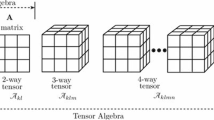Abstract
A hybrid deterministic–stochastic algorithm combining the simplex method (SM) and a genetic algorithm (GA) was applied to the problem of extracting the optical and morphological properties of human skin (HSOMPs) from visual reflectance spectroscopy data. The results using the GA-SM hybrid algorithm adopting tournament selection and selecting new sets of HSOMPs were compared with those using other conventional optimization algorithms that have generally been used for the extraction of HSOMPs. Monte-Carlo simulation showed that the suggested GA-SM hybrid algorithm enhanced the stability of the inverse solutions and computational efficiency.



Similar content being viewed by others
References
Keijzer M, Star WM, Storichi PRM (1988) Optical diffusion in layered media. Appl Opt 27:1820–1824
Shimada M, Masuda Y, Yamada Y, Itoh M, Takahashi M, Yatagai T (2000) Explanation of human skin color by multiple linear regression analysis based on the modified Lambert-Beer law. Opt Rev 7:348–352
Meglinski IV, Matcher SJ (2003) Computer simulation of the skin reflectance spectra. Comput Methods Programs Biomed 70:179–186
Dawson JB, Barker DJ, Ellis DJ, Grassam E, Cotterill JA, Fisher GW, Feather JW (1980) A theoretical and experimental study of light absorption and scattering by in vivo study. Phys Med Biol 25:695–709
Wang L, Jacques SL, Zheng L (1995) MCML – Monte Carlo modeling of light transport in multi-layered tissues. Comput Methods Programs Biomed 47:131–146
Verkruysse W, Zhang R, Bernard C, Lucassen G, Svaasand LO, Nelson JS (2005) A library based fitting method for visual reflectance spectroscopy of human skin. Phys Med Biol 50:50–70
Zhang R, Viator JA, Jung B, Svasand LO, Aguilar G, Nelson JS (2005) Determination of human skin optical properties from spectrophotometric measurements based on optimization by genetic algorithms. J Biomed Opt 10(2):024030
Douven LF, Lucassen GW (2000) Retrieval of optical properties of skin from measurement and modeling the diffuse reflectance. Proc SPIE 3914:312–323
Farrell TJ, Wilson BC, Patterson MS (1992) The use of a neural network to determine tissue optical properties from spatially resolved diffuse reflectance measurements. Phys Med Biol 37(12):2281–2286
Moczko E, Meglinski IV, Bessant C, Piletsky SA (2009) Dyes assay for measuring physicochemical parameters. Anal Chem 81:2311–2316
Choi SH, Im CH, Jung B (2009) Improvement of inverse fitting algorithm of visible reflectance spectrum to extract skin parameters. Hankook Kwanghak Hoeji 18:179–184
Keijzer M (1993) Light transport for medical laser treatment. Dissertation, Delft University of Technology
Prahl SA (1988) Light transport in tissue. Dissertation, The University of Texas at Austin
Stenn KS (1988) Cell and tissue biology. Urban and Shwarzenberg, Baltimore
Odland GF (1991) Physiology, biochemistry and molecular biology of the skin. Oxford University Press, Oxford
Renkin EM, Michel CC, Geifer SR (1984) The cardiovascular system. American Physiological Society, Bethesda
Jacques SL (1998) Melanosome absorption coefficient. http://omlc.ogi.edu/spectra/melanin/mua.html. Accessed 31 May 2010
Norvang LT, Milner TE, Nelson JS, Berns MW, Svaasand LO (1997) Skin pigmentation characterized by visible reflectance measurements. Lasers Med Sci 12:99–112
Wray S, Cope M, Delpy DT, Wyatt JS, Reynolds EO (1988) Characterization of the near infrared absorption spectra of cytochrome aa3 and haemoglobin for the non-invasive monitoring of cerebral oxygenation. Biochim Biophys Acta 933:184–192
Svasand LO, Norvang LT, Fiskerstrand EJ, Stopps EKS, Berns MW, Nelson JS (1995) Tissue parameters determining the visual appearance of normal skin and port-wine stains. Lasers Med Sci 10:55–65
Lakmaker O, Pickering JW, van Germert MJ (1993) Modeling the color perception of port wine stains and its relation to the depth of laser coagulated blood vessels. Lasers Surg Med 13:219–226
Niechajev IA, Clodius L (1990) Histology of port wine stain. Eur J Plast Surg 13:79–85
Goldberg DE (1989) Genetic algorithms in search, optimization, and machine learning. Addison-Wesley, Canada
McShane MJ, Cameron BD, Cote GL, Spiegelman CH (1999) Improving complex near-IR calibrations using a new wavelength selection algorithm. Appl Spectrosc 53:1575–1581
McShane MJ, Cameron BD, Cote GL, Motamedi M, Spiegelmann CH (1999) A novel peak-hopping stepwise feature selection method with application to Raman spectroscopy. Anal Chim Acta 388:251–264
Im CH, Jung HK, Han JY, Lee HR, Lee SY (2004) Fast and robust localization of brain electrical sources using evolution strategies: MC simulation and phantom experiment studies. Int J App Electrom 20:197–203
Acknowledgments
The author thanks the anonymous reviewers for constructive comments on the original version of this article. Also, the author is grateful to Chang-Hwan Im, PhD, Professor of the Department of Biomedical Engineering, Yonsei University, Wonju, Korea, for many useful technical suggestions to improve the quality of the present algorithm.
Author information
Authors and Affiliations
Corresponding author
Rights and permissions
About this article
Cite this article
Choi, S.H. Fast and robust extraction of optical and morphological properties of human skin using a hybrid stochastic–deterministic algorithm: Monte-Carlo simulation study. Lasers Med Sci 25, 733–741 (2010). https://doi.org/10.1007/s10103-010-0793-x
Received:
Accepted:
Published:
Issue Date:
DOI: https://doi.org/10.1007/s10103-010-0793-x




